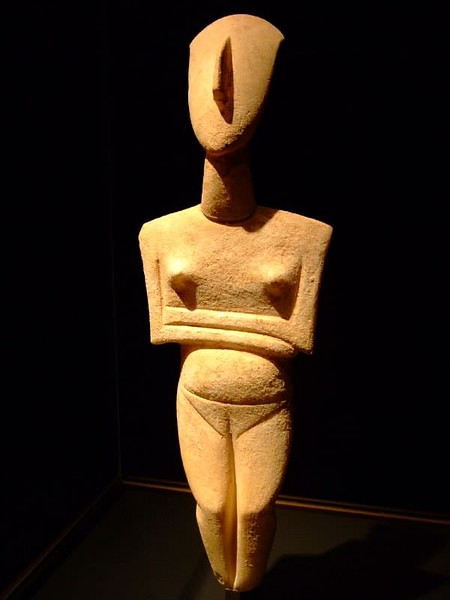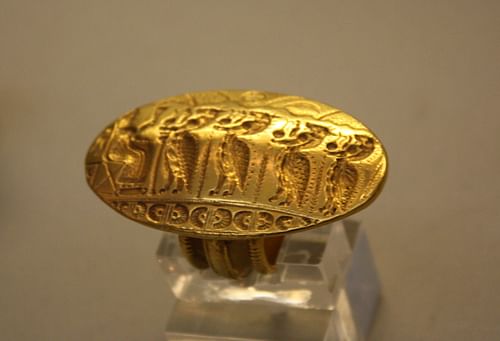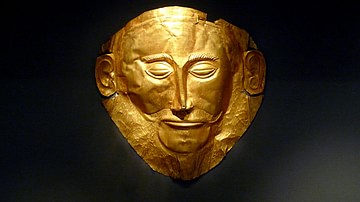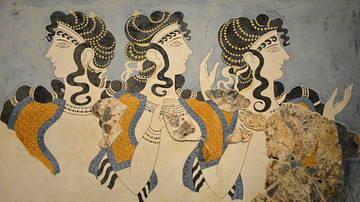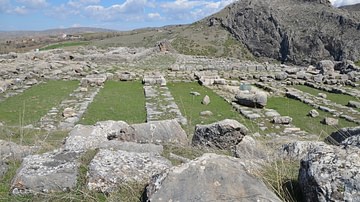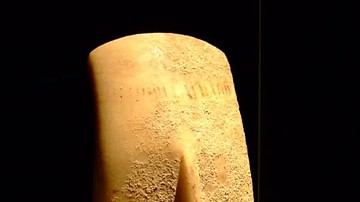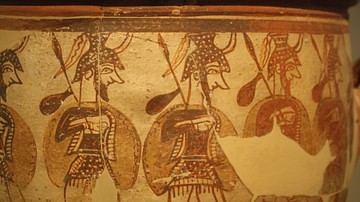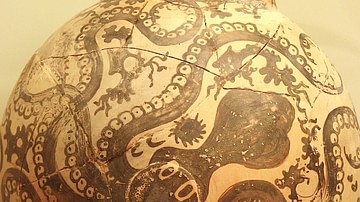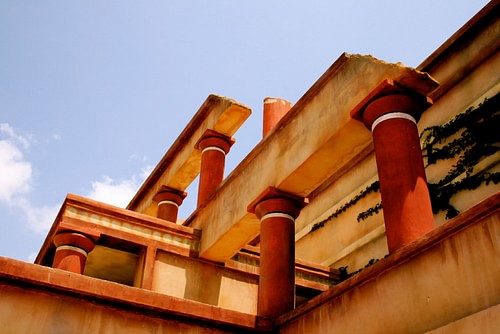
The Bronze Age (c. 3000-1000 BCE) is the period when cultures were either using, producing, or trading bronze. Several cultures flourished around the Aegean Sea during this period: the Minoan civilization on Crete, the Mycenaean civilization on mainland Greece, and the Cycladic culture on the Cyclades Islands. These three cultures developed independently and at different times whilst being in contact with each other, as well as with other regions including Egypt, Mesopotamia, Asia Minor, and the Levant.
Chronology
Dating the Aegean Bronze Age is an issue that extends into the modern day with the traditional chronologies based on ceramic typologies, known as low chronology, not reflecting the more recent scientific testing from radiocarbon dating and dendrochronology, which is referred to as the high chronology. Each main region of the Aegean Bronze Age; the Greek mainland, Crete, and the Cycladic Islands, have unique dating terminology; Helladic, Minoan, and Cycladic respectively. Each of these is split into Early, Middle and Late, and these three stages can then be further specified into specific subsections e.g., Late Minoan IIa (LM IIa).
The dating for these subdivisions is different for each culture and has been developed through cultural and ceramic changes. The broader terminology for dating across the whole of the Aegean uses the terminology Early, Middle, and Late Bronze Age, and is split roughly into these dates:
- Early Bronze Age (EBA): c. 3000-2200 BCE
- Middle Bronze Age (MBA): c. 2200-1700 BCE
- Late Bronze Age (LBA): c. 1700-1000 BCE
Early Bronze Age (c. 3000-2200 BCE)
The beginning of the Early Bronze Age on Crete marks the time before the palatial structures were built across the island. They were developing small daggers made from a mix of copper and arsenic, which shows that that the Minoans were already skilled in metalworking and were in contact with other cultures since the copper and arsenic mix was not widely available on Crete. Tombs started popping up with varied wealth deposited with the bodies, suggesting differences in wealth was beginning to show.
An important step on Crete during the Early Bronze Age was the development of settlements, with some of them growing larger than others. The most important of these was Knossos, but there is evidence of Early Bronze Age settlements in other areas including Malia and Phaistos. Social complexities on Crete have also been discerned from the discovery of seals, which were used for administrative organisation and identification, in addition to the production of stone vessels and long-distance trade with the mainland, the Cyclades, and Egypt.
Looking to mainland Greece during the Early Bronze Age, the inhabitants known as the Mycenaeans were only beginning to establish themselves in the region. By the end of the Early Bronze Age, settlements and buildings had been built. It was during the middle of this period that the fortifications of the settlements began, and the end of the period shows evidence for trade across the mainland, pottery production and sophisticated manufacturing techniques. At the site of Lerna in the Peloponnese, there is evidence for a substantial mudbrick building with staircases that boast multiple floors. From this building known as the House of Tiles, numerous seals were found with around 70 different designs, which indicates some measure of administrative organisation in the Early Bronze Age.
Settlements on the Cyclades Islands had been established during the Neolithic Period, around 5000 BCE, and during the Early Bronze Age, they began cultivating olives and vines in addition to the barley and wheat they had already been farming. Many of the Cycladic settlements displayed large populations, and evidence of seals (much like Crete and the mainland) alludes to some form of administrative system. The Cycladic peoples were busy during this period producing items out of obsidian (which was one of their most lucrative exports), copper, and bronze, sophisticated and stylised marble figures which often had their arms crossed in addition to marble vessels, a very specific frying pan form, and personal adornments out of copper and silver.
The dark-faced pottery produced at this time, known as Dark Burnished, was decorated with incisions and white paint. Interaction and trade between these three cultures has been identified in several instances including Cycladic marble figurines on both Crete and the mainland, as well as large quantities of obsidian. The export of raw materials from the Cyclades to Crete began in earnest during the middle of the Early Bronze Age and a mainland pottery form known as a sauceboat has been found on both Crete and the Cyclades. Although the trade and interactions between these three cultures increased by the end of this period, their individual cultural identities continued to develop.
Middle Bronze Age (c. 2200-1700 BCE)
Crete was now developing palatial complexes, with important sites being Knossos, Phaistos, and Malia. The function of what is often referred to as the palaces on Crete is entirely informed by the archaeology since the Linear A script of the Minoans has not yet been deciphered. What has generally been accepted as the function of these palatial centres is their use in the administrative, political, economic, and religious spheres of their community. In addition to these functions are the workshops and storage areas, and their potential use as residences for the rulers.
The first complexes emerged c. 1925-1900 BCE and are referred to as the Old Palaces. Loom weights are abundant in Middle Bronze Age Minoan centres, with 400 being found in what is now known as The Loom Weights Basement at Knossos. An increase in writing and sealing is seen during this period, and evidence for both are found at the centres as well as large buildings seemingly independent from the palatial complexes.
Minoan culture spread further, potentially as far as Samothrace, and the Minoan pottery known as Kamares Ware has been found on Cyprus, in the Levant, and in Egypt. During the Middle Bronze Age, the Minoans established their peak and cave sanctuaries throughout the island. Most of the 25 peak sanctuaries date to this period, and each of them are spatially related to a major settlement e.g., the peak sanctuary on Mount Juktas and the settlement at Knossos. Found at these cult sites are votive figurines of humans, cattle, and limbs as well as double axes (labrys).
The Middle Bronze Age was an important period in the formation of the Mycenaean societal, cultural, and political spheres. The end of the Early Bronze Age saw a widespread crisis in the southern mainland, which caused destruction of sites, depopulation, changes to funerary practices and material culture. It is not entirely clear what caused the upheaval, but potential causes are climate change and environmental issues or invasions and migrations of ethnic groups. The end of the Middle Bronze Age saw an increase in prestige grave goods being deposited in burials, which is best seen in the shaft graves of Mycenae in addition to an increase in trade with Crete and the material culture of the mainland showing greater influence by the Minoans. It is also clear that the settlements and population at Thebes, Mycenae, and Argos were beginning to grow. Graves on the mainland were developing from single internments to chamber-, tholos-, and shaft graves, which were designed to be reused.
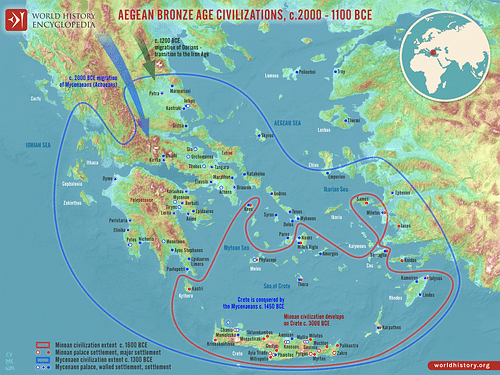
The Cyclades displayed concentrated and sophisticated settlements, which had increased in size and urban planning from the Early Bronze Age. A new pottery type was introduced into production known as Cycladic white pottery which was a matt wash decorated with abstract motifs, geometric shapes, floral, and fantastical features. This style was commonly used on beaked jugs and shallow bowls.
Late Bronze Age & Collapse (c. 1700-1000 BCE)
After the destruction of the palatial centres in 1700 BCE, only Knossos was rebuilt to its former splendour. The first few hundred years of the Late Bronze Age saw a shift in religious practices with most of the peak sanctuaries falling out of use, with only a handful associated with palatial centres continuing in use. This shift in religious practice could be attributed to the eruption of Thera between c. 1650 and 1550 BCE, which may have caused environmental changes and volcanic ash and pumice on the island. Palatial sites containing administrative tools such as seals and Linear A tablets have been excavated at Knossos, Malia, Phaistos, Zakros, and Galata dating to the Late Bronze Age. Impressions from golden signet rings have been excavated from several early Late Bonze Age sites on Crete, which shows that the centres were still in contact with each other.
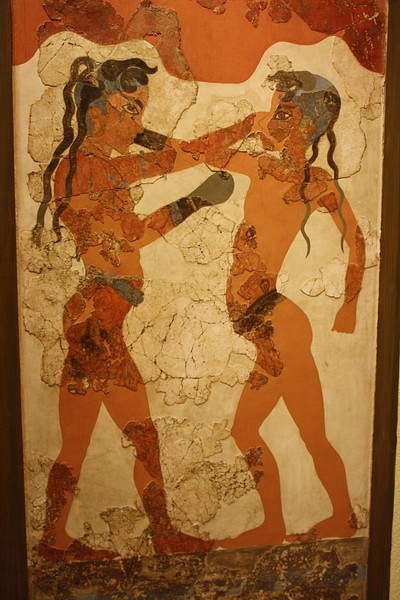
The Minoans flourished in the early Late Bronze Age with evidence of imported raw materials such as elephant tusk, copper, and tin, as well as pottery from Cyprus, Egypt, and the Levant. Around 1450 BCE widespread fires destroyed sites across Crete. The potential cause of these could be several things including internal uproar against Knossian dominance, Mycenaean domination of Crete, or natural and environmental disasters. The destruction may have been caused by a combination of these things, but we just do not know. By c. 1400 BCE, Crete exhibited a closer relationship with the mainland through weapons, warrior graves and mainland pottery styles. There is also evidence for their newfound importance in tombs and cemeteries, which is not seen on Crete earlier. By c. 1200 BCE, most of the sites were abandoned, and evidence for administrative organisation and connections with other cultures disappears.
The Late Bronze Age was the time in which the Mycenaean culture developed, flourished, and collapsed. By this time, the mainland was importing bronze and had access to small amounts of lead, copper, and silver. The Mycenaean sites that were forming in the Middle Bronze Age began showing homogeneity in addition to regional variation in the Late Bronze Age, and they featured administrative centres built around a central hall or megaron that were often fortified. The recognisably Mycenaean burials and material culture developed in earnest, and it is through the grave goods that much of our knowledge of the Mycenaean culture has been developed. The burial goods display a complex social hierarchy as well as artistic influences and preferences. They were in contact with other Mycenaean sites in addition to Crete, Italy, and Macedonia, although a preference for Minoan artistic style is obvious through both imported and local imitation and adoption of Minoan artistic styles.
Around 1400 BCE the Mycenaeans had expanded to Crete with the introduction of Linear B used for administrative purposes at Knossos. Between c. 1400-1300 BCE, Mycenaean pottery is spread more throughout the mainland, the palatial sites are adorned with frescoes, and most of our Linear B tablets come from this time, which is also known as the Palace Period on the mainland. This did not last long though, by c. 1200 BCE the palatial system on the mainland broke down, with the major complexes destroyed and not rebuilt. Some settlements were destroyed, others were abandoned, and writing fell out of the use in the region. By c. 1100 BCE there is little archaeological evidence for the Mycenaeans. This destruction and abandonment known as the Bronze Age Collapse may have been caused by natural disasters, climate change, political and social unrest, overpopulation, invasion by the mysterious Sea Peoples, or a combination of multiple factors.
Between c. 1700-1400 BCE, the Cyclades show a high degree of Minoanization through their imitation of Minoan artistic styles on pottery and frescoes, as well as architectural features such as the lustral basin or pillar room. There is the adoption of Minoan weight measurements, the Linear A script in addition to large numbers of Minoan pottery imports. Nowhere is this better demonstrated than at the site of Akrotiri which was preserved by the eruption of Thera, much like an Aegean Pompeii. It is unknown whether this Minoanization of the Cyclades was from them being routinely exposed to Minoan culture or whether the Minoans were a thalassocracy, or marine empire, during the early Late Bronze Age. Around 1400 BCE, a shift is seen in the Cyclades. The frequency of Minoan imports and influence decreases, and instead, we see the dominance of imported Mycenaean pottery and features of Mycenaean architecture (primarily tholos tombs). At the end of the Late Bronze Age, Cycladic centres and settlements are destroyed or abandoned, and the production of pottery is drastically reduced and simplified.
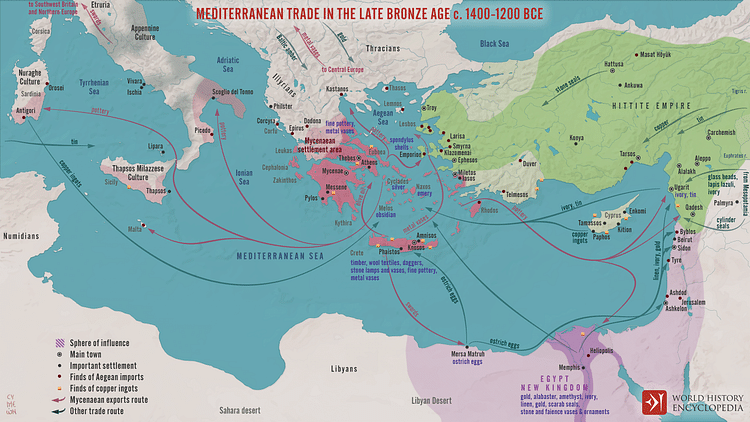
Conclusion
The Aegean during the Bronze Age sees the development, dominance, and collapse of three major cultures. At the end of the Bronze Age, settlements throughout the Aegean were small and dispersed, and writing fell out of use until the Greek Archaic Period which began in the 8th century BCE. The Greek epics, the Iliad and Odyssey by Homer, written down in the 8th century BCE for the first time, are stories of Bronze Age heroes and places from the Mycenaean, Minoan, and Cycladic world.

